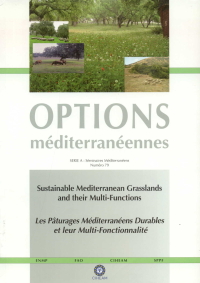| Article précédent | p. 109-112 | Article suivant |
Pasture plants of central Italy and possible traceable compounds in sheep cheese
Italian food is known for its taste and quality, but often too expensive to compete on the market. However, the greater quality and better taste of Italian food products, compared to food products from conventional agriculture, attract considerable interest from customers, and as a consequence certified organic, biodynamic and typical food products show interesting added value on the market. One of the problems with these food products is the traceability of the product from the point of origin to the customers. A research has been conducted about pasture plants that might be traced down to the final sheep caciotta cheese Pecorino Toscano. Three farms have been chosen in central Italy, each with different levels of pasture complexity, one farm on a flat area (simple botanical composition), one on a hill (medium specific diversity), and one in the mountains (highly diverse pastures). The botanic composition of all the pastures of the three farms was analysed using a linear analysis, and a list of common species was extrapolated, the most preferred species were Bromus sterilis, Lolium perenne and L. multiflorum. Finally, a list of species is given with some data about possible traceable compounds. Analyses of macro- and micro-elements by optical emission spectrometer (ICP-OES) and elemental analyzer (CHN), and of flavonoids and terpenes (HPLC) are now in progress.
Les spécialités alimentaires italiennes sont connues pour leur qualité et leur goût, mais elles sont souvent trop coûteuses pour être compétitives dans les marchés. Toutefois, leur qualité supérieure et leur meilleur goût en comparaison des produits de l'agriculture conventionnelle maintiennent un intérêt considérable du côté des consommateurs ; en conséquence, les produits biologiques certifiés, biodynamiques et traditionnels gardent une intéressante valeur ajoutée dans les marchés. L'un des problèmes majeurs qui concernent ces produits, est la traçabilité de l'origine jusqu'à la vente au détail. Une recherche a été conduite au sujet des plantes de pâturage qui peuvent être tracées jusqu'au fromage de brebis Pecorino Toscano. Trois fermes ont été choisies dans l'Italie centrale, chacune avec un différent niveau de complexité des pâturages : une ferme dans région plate (composition botanique simple), une de colline (diversité spécifique moyenne), une de montagne (pâturages avec haute diversité). La composition botanique de tous les pâturages des trois fermes a été analysée par analyse linéaire, et une liste d'espèces communes a été extrapolée. Les plus utilisées ont été Bromus sterilis, Lolium perenne et L. multiflorum. Finalement, une liste d'espèces qui contiennent de possibles substances traçables, avec quelques données au sujet de ces substances, est donnée. Des analyses de macro et micro-éléments par spectromètre à émission optique (ICP-OES) et analyseur élémentaire (CHN), et de flavonoïdes et terpènes (HPLC), sont aussi en cours.
- [ Afficher ]
- [ Télécharger ]
- [ Exporter la citation ]
Vous pouvez télécharger la citation au format :
- [ Imprimer ]
-
Mots-clés
COMPOSITION BOTANIQUE, FROMAGE DE BREBIS, ITALIE, METHODE STATISTIQUE, PATURAGES, PRODUIT BIOLOGIQUE, TRACABILITECiter cet article
Pratesi V., Ghiselli L., Pardini A., Buccioni A., Vecchio V. Pasture plants of central Italy and possible traceable compounds in sheep cheese. In : Porqueddu C. (ed.), Tavares de Sousa M.M. (ed.). Sustainable Mediterranean grasslands and their multi-functions . Zaragoza : CIHEAM / FAO / ENMP / SPPF, 2008. p. 109-112. (Options Méditerranéennes : Série A. Séminaires Méditerranéens; n. 79). 12. Meeting of the Sub-Network on Mediterranean Forage Resources of the FAO-CIHEAM Inter-regional Cooperative Research and Development Network on Pastures and Fodder Crop, 2008/04/09-12, Elvas (Portugal). http://om.ciheam.org/om/pdf/a79/00800627.pdf



